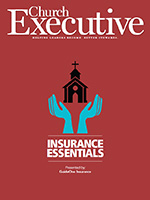
By Andy Noga
You have just met with your insurance agent to decide what type and amount of insurance coverage will best meet your church’s needs. But, before you make a decision, it’s important to read and understand the terms and conditions of the policy being offered.
 If this is the first time your church is purchasing insurance, then you might be unfamiliar with all the insurance jargon, making it difficult to understand what you’re about to buy and what insurance protection you will get for the money.
If this is the first time your church is purchasing insurance, then you might be unfamiliar with all the insurance jargon, making it difficult to understand what you’re about to buy and what insurance protection you will get for the money.
Conversely, even if you’ve heard several of the insurance terms and conditions used in general conversation, you might not fully appreciate what they mean in the context of your policy when it’s called upon to reimburse your church for a loss.
The terms and conditions of an insurance policy provide all the details of your church’s coverage. Insurance policies can be lengthy, and use complex language that’s familiar to insurance companies and agents — but not easily understood by policyholders. Unique policy language is often used as a means for insurance companies to communicate all the details of the coverage being offered in as concise and readable fashion as possible.
There are several key sections that you should know and understand well before agreeing to and accepting an insurance policy.

What’s covered? The insuring agreement and exclusions
Most likely, you and your agent have discussed numerous coverage options for your church, price plans and, hopefully, your duties and responsibilities as a church policyholder. The next step is to carefully read the policy to ensure that you understand exactly what’s covered, and excluded.
The “insuring agreement” typically defines what’s covered under a policy, and often defines certain key words used in a policy. The “exclusions” describe what’s not covered under the policy, and it’s important to understand both what is, and is not, covered in the standard form before you buy insurance.
Often, there is additional coverage, or endorsements, that a church can purchase to help better protect itself, and reduce the types of loss excluded under a policy. Since insurance policies are fairly standard and the language of those policies is often approved by the state insurance department where your church is located, amendments to policy forms are typically made by using similarly pre-approved endorsements. An endorsement is “a written document attached to an insurance policy that modifies the policy by changing the coverage afforded under the policy.” Endorsements can add or remove coverage, and understanding how the endorsements to your policy operate is critically important to understanding your church’s insurance protection.
Common insurance terms
More often than not, there will be terms within an insurance policy that you might be familiar with, but the meanings of those terms within the insurance policy might be slightly different. It’s important to note that most insurance policies, before being approved, must pass a readability test. This test is designed to ensure that a policy is easy to read and easily understood. However, not all policy provisions are uniform, and knowing the differences in language is critical.
Following are several terms commonly found in church insurance policies.
Deductible — An amount of loss (money) that the insured church must pay before the insurance company begins to make payments. Example: Your church’s insurance deductible is $500, and the church has just been hit by a tornado, causing $2,000 worth of damage. The church would first pay $500, and the insurance company would then pay the remaining balance of $1,500.
Coinsurance — In property insurance, a coinsurance provision requires that the policyholder carry insurance equal to a specified percentage of the value of property to receive full payment on a loss. If the amount of insurance limit acquired is less than the required amount, then the policyholder pays a larger percentage of the loss for being underinsured. This is often referred to as the “coinsurance penalty.”
Claim — A request made by the church for payment of the benefits provided by the policy. This is a formal request or application that’s reported directly to the insurance company. The claim is then reviewed by the insurance company to determine if the loss is covered by the policy, and if covered the claim is then paid, subject to any deductibles or coinsurance being applied.
Insured Value — The maximum amount an insurance company will pay if an insured asset is deemed a total loss. The asset’s insured value can either be its replacement cost or its market value, depending on the provisions of the insurance policy.
Liability Insurance — Protects the church from the risks imposed by lawsuits and similar third-party claims, typically bodily injury claims (for example, slips and falls), in the event that the church is sued by others.
Reading the language of your insurance policy can be tedious and sometimes frustrating. However, understanding what your church is buying — and the financial protection afforded — will better help you to prepare for the unexpected.
Reading and understanding your policy will confirm the insurance limits, who and what is insured, and reduce the risk that you and the congregation will be unpleasantly surprised when disaster strikes.
Andy Noga is Senior Vice President, General Counsel and Corporate Secretary for GuideOne Insurance in West Des Moines, IA. Noga is responsible for overseeing GuideOne’s Legal, Subrogation and Special Investigation Unit (SIU) Departments.


